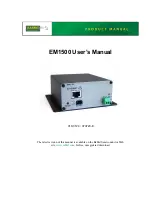
UMAX140610. LIN
– J1939 CAN Protocol Converter with PWM Output. Version 1
Page: 12-81
The discrete signals are stored in four-byte unsigned integer variables that can present any
state value in the 0…0xFFFFFFFF range.
3.1.3 Continuous Signal
The
Continuous
signal type presents continuous signals, usually physical parameters, in signal
data or as a signal input or output type.
The continuous signals are stored in floating point variables. They are not normalized and
present data in the appropriate physical units. The user can do simple scaling of the
continuous signal data by changing
Scale (Resolution)
and
Offset
configuration parameters in
the appropriate function blocks.
3.1.4 Signal Type Conversion
Discrete
and
Continuous
signals are automatically converted into each other when a signal
input of one signal type is connected to a signal output of a different signal type.
3.1.4.1 Discrete to Continuous Conversion
A
Discrete
signal is converted into a positive
Continuous
signal of the same value.
3.1.4.2 Continuous to Discrete Conversion
A positive
Continuous
signal is converted into the same value
Discrete
signal. A fractional part
of the
Continuous
signal is truncated. If the
Continuous
signal value is above the maximum
Discrete
signal value, the resulted
Discrete
signal value will saturate at the maximum
Discrete
signal value: 0xFFFFFFFF.
All negative
Continuous
signals are converted into zero value
Discrete
signals.
3.1.4.3 Undefined Signal Conversion
An
Undefined
signal is not converted into a specific discrete or continuous signal value. It
presents a no-signal condition on both:
Discrete
and
Continuous
signal inputs and outputs.
The value of an undefined signal is not defined unless a default signal value configuration
parameter is used in a function block. In this case, the configuration parameter value is used
as a signal value when the signal is not defined.













































